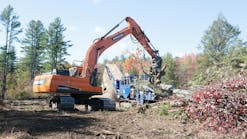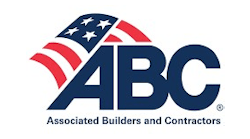It can literally sift into your soul. It gets in eyes, shoes, door jams, draperies, and your lungs. It breaks down equipment, making it old before its time. It becomes a billowing traffic hazard, pollutes water, kills crops, and can even kill you if you breathe in too much. In many areas of the country, dealing with local, state, and federal air pollution—control officials on dust-control issues is becoming as much a part of the everyday job routine as firing up a backhoe. As urbanization increases (and the bureaucrats receive more money), dust develops into more of an issue. Not surprisingly, construction is singled out as a major contributor (see Table 1), and even contractors in relatively undeveloped areas have to devise methods of reducing dust, if not for good public relations, then for their own sanity and health.“Anytime the wind kicks up they would be babysitting us,” says Chris King, land development superintendent for Sparks Construction in La Quinta, CA. “There’s really no way to control the dust in the desert once the wind starts blowing. You can have one water truck or a thousand water trucks and you can still have dust. We played the game with them, and when it was over 25 miles per hour we shut down. Anywhere from, say, 15 miles per hour to 25 miles per hour, there’s really not much you can do.”Dealing with the local Air Quality Management District was so much a part of their operations, they spent $900,000 last year on dust control. They budgeted $175,000.He says they were cited six times during the last year. One of the public nuisance charges brings a potential $15,000-$20,000 fine. They are fighting the charges through legal channels. “They can make it really hard on you if they want to,” he says. “Due to the project having ‘deep pockets,’ I think that’s why they kind of camped out on us.”According to King, the citations are for sand and dust that blow onto Sparks’ property from other lands. “We were putting down over 4 million gallons of water a day here and we’re still getting cited.”With five of their six citations coming from different air-quality officials, King suggests that contractors try to form a relationship with one official and try to sell him on the efficiency of their dust-control plan. The hope is to deal with just one bureaucrat. “Just let him see what you are trying to do to achieve no dust, if there is such a thing.” He believes that one of the options in a dust-control strategy is installation of a snow fence along the perimeter. “That will block a lot of what is coming onto you and what leaves you.” As sections of the grading are completed, spray it with a dust palliative called Soil-Sement, produced by Midwest Industrial Supply. When asked to summarize his thoughts on recently enacted standards, King echoed the views of earthmovers worldwide with this sentiment: “Take away the money they’re getting and tell them to leave us alone. I think they’ve gone a little overboard, really. If you’re going to develop in the desert, you’ve got to have [dust]. There’s only so much you can do with the resources available. When the wind blows, nothing is enough. There’s not enough you can do.”Table 1. Fugitive Dust Sources and ContributionsUnpaved Roads 28%Construction 23%Agricultural 19%Paved Roads 15%Wind Erosion 5%5%Mining/Quarrying 1%Steve Smith, project manager of Wesley Construction, another earthmoving company in La Quinta, says air-pollution bureaucrats have become a part of their life in a big way. “They actually dictate the amount of watering devices per earthmoving equipment, based on the acreage. Different-size parcels have different requirements. I mean, when you start increasing from 10 acres to 50 acres per se, or 150 acres, the requirements become more stringent. They’re looking at prewatering more. It gets all the way up to having fences that are kind of a barrier so that the dust does not mitigate off property. It becomes very daunting.”To get more efficiency from their watering operations, Smith says some contractors add chemicals to their water trucks. They use different palliatives. Some people have a fiber mulch—type application, such as hydroseeding with no seed. He says his firm currently does not use additives. “But we are looking at a project that’s about 400 acres of pure desert, and we are definitely going to need to get something that’s going to help us get that kind of penetration. I will probably be looking at Haul Road and seeing what else the industry has to offer, all the way to using Tide [laundry detergent].”He says Haul Road works to help gain penetration in “silky clay” soils. “Because there is high plasticity in some areas, it is hard to get the water absorbed. You will have more surface mud than penetration. Here our problem is penetration.” Some contractors, he adds, will actually till the soil for added penetration. According to Tony Brighi, sales marketing director of Soil-Tech, a dust-control consultant in Las Vegas, NV, adding a surfactant can save up to 30% of your water. “A surfactant is a highly concentrated soap that is going to reduce the amount of water and the amount of trips you have to take every day. A surfactant breaks the surface tension of the soil, allows the water to penetrate deeper, and therefore keeps it from evaporating as quickly. It keeps the soil moist longer, reducing the amount of applications you have to make per day. Dustac 100 is a great product to throw in a water truck, just to spray on the ground. That will give you good stabilization. Because development has been so rampant in the Las Vegas area, Brighi says grading contractors simply call dust-control consultants to handle dust suppression. “Right now we are selling a little bit of surfactants. I do have a couple of small companies that I sell to where they apply it themselves. But typically what I’ve found in the Las Vegas area is people who want us to do it. There’s so much construction going on that these guys don’t want to spend the time doing anything, and I guess the economy is [strong] enough that they are willing to pay for a service like ours to come out and apply it.
Application of a soil stabilizer“Anything that has been graded or disturbed in any way after completion of the project has to be capped off, which means it has to have a dust palliative on it. Dustac with paper mulch is what we use more than anything else. We probably do 1,500 acres a year here in Las Vegas, and we’ll probably do more than that this year.”Air pollution—control officials were a permanent fixture at an Exxon project near Gaviota, CA, in the late 1980s. Brad Williams, construction manager for Granite Construction’s branch office in Sacramento, CA, says there were three air-monitoring stations on-site as they carved up about 120 ac. of canyon country into roads and prepared the land for construction of a processing facility. They moved some 5 million yd. of dirt, making cuts as much as 400 ft. deep and fills 300 ft. high.“We were working with the Air Pollution Control District that had monitoring people on-site full time, and it turned out to be a very proactive and a very successful project,” recalls Williams. “We like to think we’re proactive with the authorities and work to come up with the best solutions we can. It’s probably one of the reasons we haven’t had a lot of difficulties per se, or fines, because we’re working with the authorities. The idea is how to figure out how to keep the dust out of the air.” There were some days when they were required to shut down because of dust caused by high winds.Dustac includes a glue made of lignin to help keep down dust on roads and construction sites.One of the measures used to comply with particulate matter standards involved adjusting the timing on the engines of their equipment. “You can retard the timing about 3 degrees on the engines and that helps with your emission control.” They also changed from a standard sulfur diesel fuel to a lower sulfur content that cuts emissions. Another dust-control technique he recommends is premoistening the soil. “Getting the water into the soil before disturbing the soil is the much more effective way, rather than trying to excavate dry dirt and trying to knock the dust back down out of the air,” he says. “I would call that more reactive than proactive, and the proactive method is much more effective.” He says they limit driving speeds at construction sites and schedule work for hours when the wind is less likely to blow.Williams says his company does not use additives in its water trucks. “We’ve looked into it. We’ve used it. We’ve had varying degrees of success. We haven’t found it that beneficial on a long-term project that’s actively being constructed. Now, if you have a project that goes into a 30-day hold period or you’re going to be shut down on the heavy grading operations for a significant time, you can put dust palliatives down and it helps with the wind. But we haven’t had that much success in an ongoing construction activity. This is an issue we’ve been dealing with for many years. We’ve been trying to make sure we’re in compliance with the particulate matter regulations and air emissions. We’ve been able to find success with the adequate coverage of water trucks.”Dave Lippert, project manager of Neuvo Engineering, a grading contractor in Bermuda Dunes, CA, (30 mi. east of Palm Springs), says they have had to shut down operations because of dust (approximately 10 days a year) more times than because of rain. “It’s cheaper to shut down than to get fined.“Down here [near Palm Springs], because of the sand, we put sprinklers out before we start grading to get moisture in the sand. If you went out and tried to move dirt with scrapers right now without water, you’d have dust everywhere. It’s also to get compaction. You can’t drive through the sand because it’s so soft without any moisture. Say you’ve got 10 feet to cut, then you’ve got to get moisture down there 10 feet. So we set up Rain Birds all over the site to start, and we kind of stagger that to the area we are working.”He says they are not considering water additives at this time. “What that’s going to do is just raise prices for the owner. Instead of putting additives in the water, we just come and spray it with a soil stabilizer after it’s to grade.”According to Robert Nelson, operations manager for Crystal Cascades, a general contractor in Las Vegas, new dust-control standards bring a new headache: wading through the permit process. “It takes a couple of weeks to do the permitting process. Plus, within that you have to send somebody down there to get trained on how to fill out these forms. It’s not just a simple little thing where you can pick up a handbook and kind of read through it. The Health District has seen that and has made provisions to have dates when they will have a class where you can ask questions about how to fill out these things. So they’re trying to help you out. Still, it’s pretty difficult.”Nelson has these tips for getting the most out of your water trucks: “The art is getting the soil to where it isn’t so wet that it’s tracking out everywhere on the road and putting it down in a sufficient quantity so that it does depress the dust, it allows you to go to another area, and it allows you to come back and do your circle [in your earthmover].”He says additives and palliatives are superfluous during the grading part of the project. “Maybe it’s the last area you are going to hit, but it doesn’t make any sense when you’re actually out there building an area. Say you’ve got a big cut-fill operation going on. Every time the scrapers go by they’re throwing a foot of dirt down in an area and you’re compacting it and coming up on top of another foot of dirt.”Nelson says he sees a day when grading professionals will lay down their own dust palliatives to cap off the soil after completing the excavation. “In the future I foresee the contractors starting to do that themselves, the bigger prime contractors. I wouldn’t do it because I don’t do enough grading and paving jobs to where I would pencil for my capitalization of equipment. If I was the operations manager or someone higher in the company, I would definitely look at it.” Scott Kohler, a former excavator, is now the director of environmental and marketing for JTC Environmental in East Alton, IL. He says they used to use additives such as calcium chloride and magnesium chloride. They now use a product called PennzSuppress. “We are very happy with it. It’s environmentally friendly. It does an excellent job. We do a lot of dust control, a lot of steel mills. We use it as a primer before they pave. We do a lot of truck terminals, some construction sites, primarily to hold the dust down. We do new parking lots, new paving jobs. We spray on coal piles to hold the dust down.“We’ve done a lot of excavating at steel mills. They haul a lot of slabs of steel, and the roads are getting so built up with dust-control products that we tear them down a couple of feet, get them back down to grade.”Using a palliative can save significantly on water-truck costs.Clint Pearce, project manager for Madonna Construction in San Luis Obispo, CA, says they use water trucks and schedule work for the less windy times of the day. He says they will continue to use water trucks without additives, especially if the City of San Luis Obispo continues to provide free recycled, nonpotable water to contractors. “There are a lot of products out there. I guess until we start getting charged more for our water and it starts being more advantageous to use something else, we will probably keep on using water, unfortunately.“Certain communities have started to charge a lot for their water, and it makes a person look for other alternatives. And we have to look at our specs, like Caltrans work, to make sure they allow certain dust palliatives. Not all agents are OK to use from all agencies. Most of what we do is public work, so we have to make sure that whatever we are using is in compliance with whomever owns the job. That’s part of the reason why we haven’t used these other agents for dust suppression, because they have to be cleared by the agencies that we are working for.”“Every job is a little bit different,” says Alex Madonna, owner of Madonna Construction. “Pretty much water is your best control. Depending on where you are, you may use some kind of an additive. It helps a little bit. Sometimes you have a little problem with a material taking water, so you add a little soap; some kind of additive. There are several things you can do that helps get the material to compact in the grade you’re going into.”Bob McCrea of Georgia-Pacific estimates that contractors can save significantly on water-truck costs by using a palliative. He recommends Dustac 100 and Roadbinder on roads and construction sites. “There are other alternatives, such as using our material in their water trucks to either extend the life of the water on the road to make it last longer or to actually develop a hard, permanent surface. Our material is actually a glue that is composed of lignin, and lignin is what holds wood cells together in a tree. And there’s about 35% to 50% in every tree that grows.”“There are numerous chemical stabilizers on the market, everything from magnesium or calcium chlorides, which are primarily waste from salt producing operations, to much more high-tech liquid polymers,” says Frank Elswick, western regional manager for Midwest Industrial Supply, one of the largest dust-control companies in the nation. “We deal with everything from construction projects for residential or large commercial to airport grading and runway extension to unpaved residential or rural roadways.”He says they use three major products: Soil-Sement; a synthetic fluid called Enviro-Clean and EK35; a synthetic fluid that has natural rosins. “These guys who are watering primarily large construction sites: They may be using six to eight water trucks 24 hours a day during the windy months, particularly in desert regions. Those water trucks are probably costing from $50 to $60 an hour and that doesn’t include the cost of the water. A product such as Soil-Sement can be used one time and be suitable on traffic areas for up to 12 months.“Some of these construction sites sit for two or three years before they are completely built out, and it’s not feasible to keep water trucks going for that long of a period,” says Elswick. “If some of these people do insist on watering, there are surfactants that can be added to the watering operation. For example, 1 gallon of surfactant per 500,000 gallons of water will make the watering twice as effective. Basically these are agents that break the surface tension of the water that allows for better penetration and saturation of the soil particles. There’s a lot of things that you can do.”Another expert in the field of dust control is Paul Bradley of Allied Pacific Environmental Corporation, a hydraulic planting and erosion control contractor in St. George, UT. He endorses a product called TopCoat, produced by Central Fiber Corporation. “We use a slurry that’s applied hydraulically through a conventional hydroseeding machine. It’s got a mix of cellulose fiber, organic tackifier, and water. And there are various links of control, depending on what the need is. Some folks like a year of control. Basically what it does is stabilize dust in nontraffic areas.”When it comes to stabilizing haul roads, McCrea says they concentrate on everything from the shoulder outward. “We apply these slurries, these dust-control solutions on the shoulders, where you get that billowing–that vacuuming effect from the vehicular traffic. We don’t actually do stabilization on the road surface. We treat the shoulders because they are one of the major contributors to fugitive dust and it billows behind the vehicles as they drive by.”While it is used mainly for demolition or mining operations, one way of fighting dust involves utilizing a fogging system. David Gilroy of Advanced Dust Solutions Inc. says they shoot fog into the dust area. Fog droplets are about the same size as the airborne dust. “If you can get those two to mix up, what happens is the dust particles stick to the water droplets and it adds weight to the dust particles. Their increased mass makes them fall back out of the air.” It can only be used in an area that has a pocket or cover.Gilroy suggests a comprehensive approach to dust control. “In most cases when you’re talking dust control, people have to look at a comprehensive approach. In other words, there’s not really one thing they can do. There could be a combination of things. If a guy is operating a front-end loader and he can slow down a little bit, sometimes that’s enough to help. Sometimes combining the use of water trucks with something else, like having a guy with a water hose or putting a wind screen up or combining all of those–that’s how you get your reduction.”








